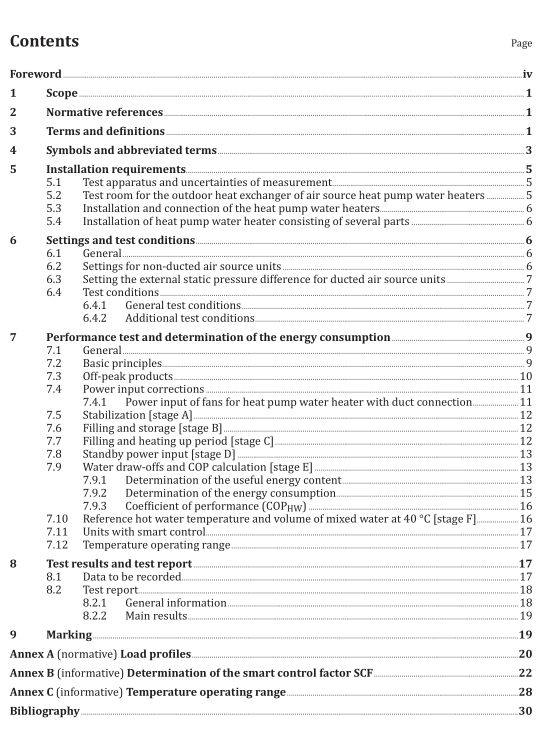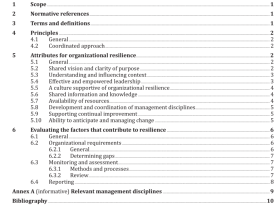ISO 19967-1 pdf download

ISO 19967-1 pdf download Heat pump water heaters — Testing and rating for performance — Part 1: Heat pump water heater for hot water supply
Unless otherwise stated by the manufacturer, the air inlet and air outlet orifices shall not be less than1 m from the surfaces of the test room; this also applies to any measuring ducts.
Any direct heat radiation (e.g. solar radiation) onto heating units in the test room onto the heat pumpwater heater or onto the temperature measuring points shall be avoided.
5.3 Installation and connection of the heat pump water heaters
The heat pump water heater shall be installed and connected for the test as recommended by themanufacturer’s installation and operation manual. The accessories provided by option (for exampleheating element) are not included in the test. Temperature and pressure measuring points shall bearranged in order to obtain representative mean values.
5.4 Installation of heat pump water heater consisting of several parts
Iln the case of heat pump water heaters consisting of several refrigeration parts (split heat pump waterheater) the following installation conditions shall be complied with for the tests:
a) each refrigerant line shall be installed in accordance with the manufacturer’s instructions; thelength of each line shall be between 5 m and 7,5 m;
b) the lines shall be installed so that the difference in elevation does not exceed 2,5 m;
c)thermal insulation shall be applied to the lines in accordance with the manufacturer’s instructions;d) unless constrained by the design, at least half of the interconnecting lines shall be exposed to the
outdoor conditions with the rest of the lines exposed to the indoor conditions.
For indirect systems where the heat pump water heater is separated from the tank, water or brineconnections to the tank shall be installed in accordance with the manufacturer’s instructions to themaximum stated length or 5 m whichever is shorter. Piping shall be well insulated and made as short aspossible and with as few bends as possible.
6 Settings and test conditions6.1General
Set points for internal control equipment of the unit such as thermostats, pressure switches or mixingvalves shall be set to the values as stated in the installation and operating instructions. If several setpoints or a range are stated, the manufacturer shall indicate the one to be used for the tests.
Thermostat settings and settings for supplementary electrical heaters shall be done according to theinstallations and operating instructions and shall remain in the same position for the duration of thetest. If the heat pump water heater is equipped with a mixing valve for the hot water, this valve shall beset at the manufacturer’s recommended setting throughout the test.
6.2Settings for non-ducted air source units
For non-ducted units, the adjustable settings such as louvers and fan speed shall be set according to theinstallation and operating instructions. Without information from the manufacturer, louvers and fanspeed shall be set for maximum air flow rate.
6.3Setting the external static pressure difference for ducted air source units
The volume flow and the pressure difference shall be related to standard air and with a dry heatexchanger. If the air flow rate is given by the manufacturer with no atmospheric pressure, temperature,and humidity conditions, it shall be considered as given for standard air conditions.
The air flow rate as stated in the installation and operating instructions shall be converted intostandard air conditions.The air flow rate setting shall be made when the fan only is operating.
The rated air flow rate as stated in the installation and operating instructions shall be set and theresulting external static pressure (ESP) measured.
lf the ESP is lower than 30 Pa, the air flow rate is decreased to reach this minimum value.The apparatusused for setting the ESP shall be maintained in the same position during all the tests.
lf the installation and operating instructions state that the maximum allowable duct length is for inletand outlet together less than 2 m, then the unit shall be tested with the duct length and the ESP isconsidered to be 0.
6.4Test conditions
6.4.1 General test conditions
The tests shall be carried out at the test conditions specified in Table 3 and Table 4 as appropriate.Permissible deviations shall not exceed the values specified in Table 2. In addition,the maximalpermissible deviation of thermal energy for the complete load profile shall be less than 5 %.









